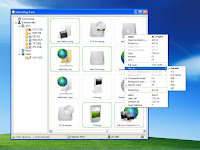
The Slideshow is a modern concatenation of "Slide Show". A slideshow is a display of a series of chosen images, which is done for artistic or instructional purposes. When Slideshows conducted by a presenter using an apparatus, such as a carousel slide projector, an overhead projector or in more recent years, a computer running presentation software. The term originates from the use of slides which have been around for many years. Slides originally were projected on movie theater screens by magic lanterns as part of the program of early moving picture shows.
A well organized slideshow allows a presenter to lend visual images to an oral presentation. The old adage "A picture is worth a thousand words" holds true, in that a single image can save a presenter from speaking a paragraph of descriptive details. As with any public speaking or lecturing, a certain amount of talent, experience, and rehearsal is required to make a successful slideshow presentation.
A well organized slideshow allows a presenter to lend visual images to an oral presentation. The old adage "A picture is worth a thousand words" holds true, in that a single image can save a presenter from speaking a paragraph of descriptive details. As with any public speaking or lecturing, a certain amount of talent, experience, and rehearsal is required to make a successful slideshow presentation.






